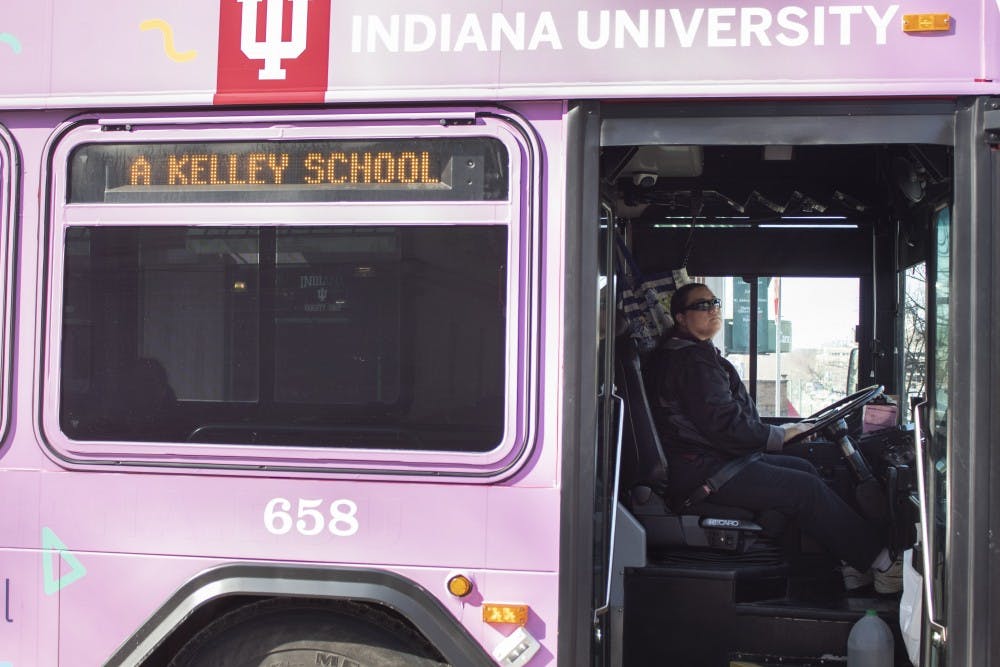Before junior Nick Egloff could start his part-time job, he had to learn how to parallel park a 40-foot-long, 29,000-pound bus.
Egloff is one of about 20 students who drives for the Campus Bus Service. When he’s not in class, he drives the A, W and W-Limited buses for about 16 hours a week.
“It’s different than a lot of other jobs,” he said. “It’s not a kind of job where you can help a customer for five minutes and then go back to playing on your phone.”
IU’s bus service relies on students as part-time drivers to fill gaps from full-timers and keep operation hours consistent. But the number of student drivers is not what it once was.
The Campus Bus Service is operating more hours than ever before, clocking in at 46,000 hours during the school year, Noojin said. But it employs 30 fewer student drivers than it did in 2014.
If the shortage continues and the student transportation fee is not raised, the bus service may have to continue cutting hours. The B route already shortened its weekend hours earlier this year, and although Bloomington Transit is a separate entity, it stopped running the Night Owl last year.
Brian Noojin, assistant operations manager for the Campus Bus Service, said the Department of Transportation started enforcing stricter requirements for hiring drivers a few years ago, which has contributed to a student driver shortage.
Students now must be at least 21 years old to apply in Indiana. Noojin said many student drivers now graduate within the year they’re hired.
“When you look at the difference between what you can do when you can recruit students at 18 or 19 versus 21, we're really limited there,” he said.
Additionally, those who apply now have to pass a more strict physical exam than before. Someone with Type 2 Diabetes would no longer be able to drive, Noojin said, so the driver does not have to inject insulin on the job.
Egloff started training to drive the bus in September. After training and a commercial driver’s license exam, he finally got behind the wheel this semester.
He said the perks of the job, such as flexible hours and a starting hourly wages of $15, outweigh the rigorous training that lasts weeks. Still, he said it’s not a job for everyone.
“It’s definitely more upfront work than you would normally have working a part-time job,” he said. “It’d be a lot easier to go work at, like, Wendy’s.”
The part-time driver shortage also creates extra costs for the bus services, Noojin said. But IU’s student transportation fee, which covers almost all bus expenses, hasn’t increased in years.
But costs, which includes wages, keep rising.
With fewer part-time drivers, the service has to rely more on full time staff members, who are paid more and work more often.
A few weeks ago, Noojin met with the Committee for Fee Review, a group of students who decide on any increases or decreases in student fees.
Noojin proposed raising the student transportation fee, currently $64.60 per semester, by 3 percent.
Alex Wisniewski, IU Student Government President and member of the committee, said the transportation fee cannot decrease because the bus system is essential for many students and needs a certain amount of money to operate.
“When you consider that each bus is half a million dollars, you can’t just cut their budget and think that all will be well,” Wisniewski said. “This isn’t just monopoly money.”
But this doesn’t mean the committee will approve the fee increase, either.
If it is not approved, Noojin said he will have to reassess the campus bus services, starting with potentially reducing weekend and break operation hours.
“We’d have to make some difficult decisions,” he said.
Noojin said the service is not planning on decreasing full-time drivers but would like to recruit more part-timers.
Egloff said full-time drivers are more experienced driving, but student drivers benefit from already knowing the campus well. Still, whether a driver is full- or part-time, everyone is working toward the same goal, he said.
“Most people’s contact with the drivers is not more than half a second when you’re getting on the bus,” he said. “But they’re all very dedicated to getting people to places safely.”




